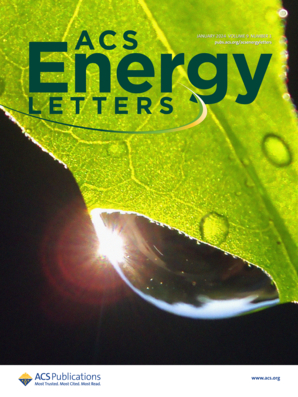微电子系统用4.6 V licoo2基全固态薄膜电池中纵向(003)织构低应变扩散通道的构建
IF 19.3
1区 材料科学
Q1 CHEMISTRY, PHYSICAL
引用次数: 0
摘要
无人监控的发展趋势和智能自动化的广泛普及要求自供电微型电池具有更高的储能能力。全固态薄膜锂电池在尺寸和集成度方面具有显著优势,但仍然受到低电压平台(3.3 V)和微安级容量(≤0.2 mWh)的限制。在此,我们提出了结合衬底锚定效应的晶体面工程来解决4.6 V LiCoO2薄膜的关键结构变化。旋转的(003)基面有效地消除了内应力和Li+迁移能垒,增强了Nb2O5@LCO纳米片的连续迁移通道和结构骨架。因此,无添加剂的全电池表现出优异的可循环性,在3.0 ~ 4.6 V、1.4 C、500次循环中保持72.5%的容量保持率,在3.5 cm2的薄膜电池中具有1.148 mWh cm-2的高能量密度。这项研究提供了一种原型方法,为进一步的片上微器件定制所需的兼容薄膜电极材料。本文章由计算机程序翻译,如有差异,请以英文原文为准。

Construction of Longitudinal (003) Textured Low-Strain Diffusion Channel in 4.6 V LiCoO2-Based All-Solid-State Thin Film Battery for Microelectronic Systems
The growing trend of unmanned monitoring and the widespread popularity of intelligent automation necessitate higher energy storage for self-powered microbatteries. All-solid-state thin-film lithium batteries offer significant advantages in size and integration but are still subject to their low-voltage plateau (<3.3 V) and microampere-level capacity (≤0.2 mWh). Herein, we proposed the crystal-facet engineering combined with the substrate anchoring effect to address critical structure variation in the 4.6 V LiCoO2 film. The rotated (003) basal plane effectively relieves internal stress and the Li+ migration energy barrier, contributing to strengthened continuous migration channels and a structure skeleton in Nb2O5@LCO nanosheets. Therefore, the additive-free full cell exhibits excellent cyclability, retains 72.5% capacity retention over 500 cycles at 1.4 C between 3.0 and 4.6 V, and has a high energy density of 1.148 mWh cm–2 in a 3.5 cm2 thin-film cell. This study provides a prototype method for tailoring desired compatible thin film electrode materials for further on-chip microdevices.
求助全文
通过发布文献求助,成功后即可免费获取论文全文。
去求助
来源期刊

ACS Energy Letters
Energy-Renewable Energy, Sustainability and the Environment
CiteScore
31.20
自引率
5.00%
发文量
469
审稿时长
1 months
期刊介绍:
ACS Energy Letters is a monthly journal that publishes papers reporting new scientific advances in energy research. The journal focuses on topics that are of interest to scientists working in the fundamental and applied sciences. Rapid publication is a central criterion for acceptance, and the journal is known for its quick publication times, with an average of 4-6 weeks from submission to web publication in As Soon As Publishable format.
ACS Energy Letters is ranked as the number one journal in the Web of Science Electrochemistry category. It also ranks within the top 10 journals for Physical Chemistry, Energy & Fuels, and Nanoscience & Nanotechnology.
The journal offers several types of articles, including Letters, Energy Express, Perspectives, Reviews, Editorials, Viewpoints and Energy Focus. Additionally, authors have the option to submit videos that summarize or support the information presented in a Perspective or Review article, which can be highlighted on the journal's website. ACS Energy Letters is abstracted and indexed in Chemical Abstracts Service/SciFinder, EBSCO-summon, PubMed, Web of Science, Scopus and Portico.
 求助内容:
求助内容: 应助结果提醒方式:
应助结果提醒方式:


